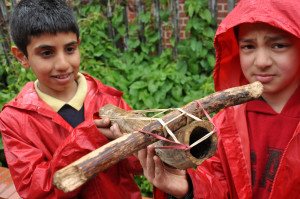com·mon·sense \?kä-m?n-?sen(t)s\ adjective : sound and prudent judgment based on a simple perception of the situation or facts
People often say that effective risk assessments are the application of common sense. I tend to agree, but, different people have different perceptions based on their differing experience. The questions are then; how do we collect all that sense? How do we hold it in common so that everyone in a team, organisation or partnership shares the wealth of experience on offer? This is the role, to my mind, of the risk assessment. The process of collecting all that experience and judgment together to give us a ‘common sense’ of what is possible and how we make it work for the benefit for the participants.
But when children are given the opportunity to direct their own play and learning, then what they are doing could go beyond the collective experience which is recorded in those risk assessments. How do we make judgements then?
Recently one of the boys in a Forest School session produced some rubber bands from his pocket. The postmen drop them all up and down along the road we walk to the woods. We had been making musical instruments and he had an idea to make a guitar. But as he worked away, the thing evolved. “It looks a bit like a crossbow” he said and he was right! I knew that I hadn’t discussed with the teacher what we would do if the session moved into the manufacture of weapons. This thing looked lethal but, was the risk proportional to the benefit? He looked so excited and proud of his creation; he had worked well with another boy to bring an idea to reality and seen the potential over and above the initial starting point. These are all benefits, but would the benefits still exist if the crossbow did not? I know from experience that when you have made something that looks functional you have to know if it works or not. The benefit would be diminished if we didn’t know if it worked and we would lose the opportunity to tinker with it and make it work better.
I asked him to sum up of all the responsibilities of having such a weapon. To tell me the safety precautions he should take. He came up with some very good ideas which we all agreed on. We decided that if he went beyond this agreement then I could claim the crossbow as my own forever and he fired it toward the brambles. It didn’t just fire, it fired really well! There was a collective whoop. Something wonderful had been created. Our next session in the woods involved the manufacture of a lot of bows and arrows. We all had a new surge of creativity and engagement and all of this was managed without the risks outweighing the benefits.
We collect together our experiences in written risk assessments but the children are then exploring in another direction. For any practitioner, like I found with the construction of the crossbow, there are always a series of judgements that take place when this happens.
Step 1: Oooh! Look at that, that’s interesting…
Step 2: Am I comfortable with that?
Step 3: Shall I intervene or is it fine to carry on?
Step 4: If we do carry on how will we do that safely? Etc…
I have come across this again and again. A few years ago I had responsibility for the effective implementation of health and safety for a large team of staff who worked with children and young people, outdoors, in a variety of environments delivering adventurous, risky, child led opportunities and we came across it there too. We adopted some work on Dynamic Risk Management done by Dan Rees-Jones of the University of Gloucester, part of the Playwork Partnerships network. He came up with a flowchart which follows the decision making path along the steps outlined above. Dynamic Risk management is about using observations and reflecting in that moment, are the benefits proportional to the risk? As a team we adopted this, tweaked it slightly to fit our situation and used it as a shared protocol that helped us share a sense in common of what to do when we didn’t feel comfortable or something unexpected happened. It also helped us reflect on decisions we had taken and make better decisions again at future times.
I came back to this Dynamic Risk Benefit Assessment flowchart recently. Even though I don’t work with a regular team any more I wanted something similar to use for my Forest School sessions. I work in partnership with teachers or other practitioners who I may only get to be with once a week. The more we have that helps us have a sense in common of what is OK, then the easier it is to be giving consistent message to the children. The most fundamental changes stemmed from one of those ‘sit-up-the-middle-of-the-night’ moments of inspiration I had about the interrelationship between environment, risk and behaviour.
If you can’t re-establish play or self directed learning with intervention then it is the behaviour that is the problem not the environmental hazard. I don’t just mean the children’s behaviour though. I have witnessed practitioner’s behaviour causing risks and escalating risky behaviour in others. I also started to ask myself the question when does risk management become behaviour management?
Here is a link to my reworked version, I would be interested in seeing what other practitioners think of it. I look forward to hearing your thoughts….
This post, written by Lily, was first published on www.outdoorplayandlearning.com in 2011 and is reproduced here with their kind permission.












Hi Lily – I love your dynamic risk assessment – would you mind if I use it in my level 3 portfolio? I’ll credit you as the source of course. Many thanks, Liz.
Of course. Please do use it and share with others on your course. Lily